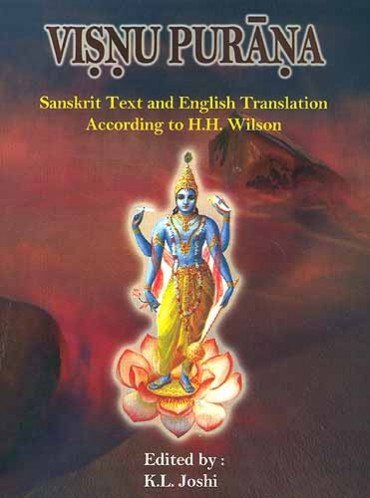The Vishnu Purana
by Horace Hayman Wilson | 1840 | 287,946 words | ISBN-10: 8171102127
The English translation of the Vishnu Purana. This is a primary sacred text of the Vaishnava branch of Hinduism. It is one of the eighteen greater Puranas, a branch of sacred Vedic literature which was first committed to writing during the first millennium of the common era. Like most of the other Puranas, this is a complete narrative from the cr...
15. The Kūrma Purāṇa
15. Kūrma Purāṇa. “That in which Janārddana, in the form of a tortoise, in the regions under the earth, explained the objects of life—duty, wealth, pleasure, and liberation—in communication with Indradyumna and the Ṛṣis in the proximity of Śakra, which refers to the Lakṣmī Kalpa, and contains seventeen thousand stanzas, is the Kūrma Purāṇa[1].”
In the first chapter of the Kūrma Purāṇa it gives an account of itself, which does not exactly agree with this description. Sūta, who is repeating the narration, is made to say to the Ṛṣis, “This most excellent Kaurma Purāṇa is the fifteenth. Saṃhitās are fourfold, from the variety of the collections. The Brāhmī, Bhāgavatī, Saurī, and Vaiṣṇavī, are well known as the four Saṃhitās which confer virtue, wealth, pleasure, and liberation. This is the Brāhmī Saṃhitā, conformable to the four Vedas; in which there are six thousand ślokas, and by it the importance of the four objects of life, O great sages, holy knowledge and Parameśvara is known.” There is an irreconcilable difference in this specification of the number of stanzas and that given above. It is not very clear what is meant by a Saṃhitā as here used. A Saṃhitā, as observed above (p. xi), is something different from a Purāṇa. It may be an assemblage of prayers and legends, extracted professedly from a Purāṇa, but is not usually applicable to the original. The four Saṃhitās here specified refer rather to their religious character than to their connexion with any specific work, and in fact the same terms are applied to what are called Saṃhitās of the Skānda. In this sense a Purāṇa might be also a Saṃhitā; that is, it might be an assemblage of formulæ and legends belonging to a division of the Hindu system; and the work in question, like the Viṣṇu Purāṇa, does adopt both titles. It says, “This is the excellent Kaurma Purāṇa, the fifteenth (of the series):” and again, “This is the Brāhmī Saṃhitā.” At any rate, no other work has been met with pretending to be the Kūrma Purāṇa.
With regard to the other particulars specified by the Matsya, traces of them are to be found. Although in two accounts of the traditional communication of the Purāṇa no mention is made of Viṣṇu as one of the teachers, yet Sūta repeats at the outset a dialogue between Viṣṇu, as the Kūrma, and Indradyumna, at the time of the churning of the ocean; and much of the subsequent narrative is put into the mouth of the former.
The name, being that of an Avatāra of Viṣṇu, might lead us to expect a Vaiṣṇava work; but it is always and correctly classed with the Śaiva. Purāṇas, the greater portion of it iñculcating the worship of Śiva and Durgā. It is divided into two parts, of nearly equal length. In the first part, accounts of the creation, of the Avatāras of Viṣṇu, of the solar and lunar dynasties of the kings to the time of Kṛṣṇa, of the universe, and of the Manvantaras, are given, in general in a summary manner, but not unfrequently in the words employed in the Viṣṇu Purāṇa. With these are blended hymns addressed to Maheśvara by Brahmā and others; the defeat of Andhakāsura by Bhairava; the origin of four Śaktis, Maheśvarī, Śivā, Śatī, and Haimavatī, from Śiva; and other Śaiva legends. One chapter gives a more distinct and connected account of the incarnations of Śiva in the present age than the Liṅga; and it wears still more the appearance of an attempt to identify the teachers of the Yoga school with personations of their preferential deity. Several chapters form a Kāśī Māhātmya, a legend of Benares. In the second part there are no legends. It is divided into two parts, the Īśvara Gīta[2] and Vyāsa Gita. In the former the knowledge of god, that is, of Śiva, through contemplative devotion, is taught. In the latter the same object is enjoined through works, or observance of the ceremonies and precepts of the Vedas.
The date of the Kūrma Purāṇa cannot be very remote, for it is avowedly posterior to the establishment of the Tāntrika, the Sākta, and the Jain sects. In the twelfth chapter it is said, “The Bhairava, Vāma, Ārhata, and Yāmala Śāstras are intended for delusion.” There is no reason to believe that the Bhairava and Yāmala Tantras are very ancient works, or that the practices of the left-hand Śāktas, or the doctrines of Arhat or Jina were known in the early centuries of our era.
Footnotes and references:
[1]:

Click to view
[2]:
This is also translated by Col. Vans Kennedy (Anc. and Hindu Mythol., Appendix D. p. 444); and in this instance, as in other passages quoted by him from the Kūrma, his MS. and mine agree.
